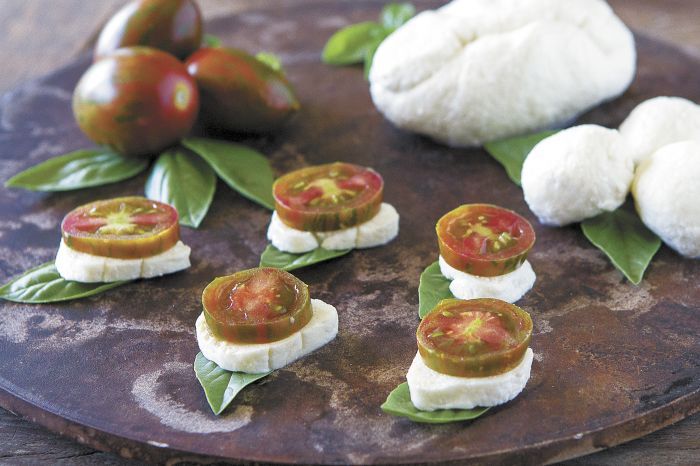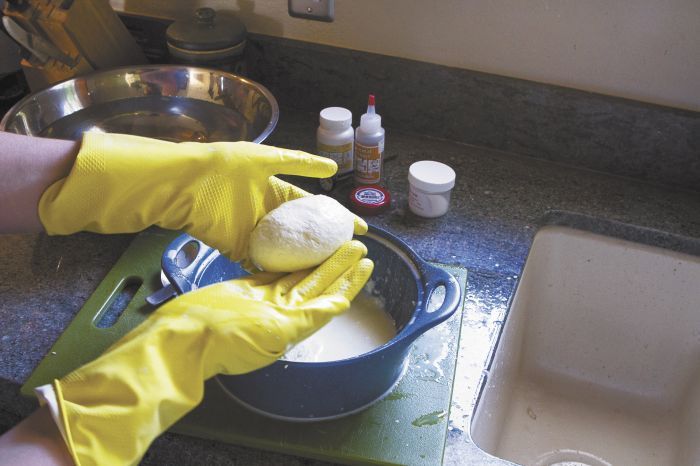DIY Mozzarella


Experiment at home makes for cheesy challenge
By Christine Hyatt
As temperatures rise and luscious tomatoes ripen next to aromatic basil in gardens near and far, the season for the summer classic Caprese Salad has arrived.
This simple dish originated in Campania, and boasts all the colors of the Italian flag. It’s all about peak of season flavor and freshness, like tasting summer on a plate.
This year, with basil and tomatoes from my garden, I decided to try my hand at DIY Mozzarella to complement my homegrown bounty. Luckily there are a plethora of great recipes in books and online. My local homebrew shop had supplies. Citric acid, animal rennet, a coagulant, and Lipase, an optional flavor ingredient, in hand, I bought a gallon of fresh milk at the grocery.
My first experience using the most popular online recipe for “30-minute Mozzarella,” was a success, for the most part. The transformation of milk from a liquid to solid form with the addition of a few simple ingredients and heat worked as described and was quite magical. My boys enjoyed the simple, edible science experiment and the resulting stretchy cheese. Cheese with good texture while warm and a decent flavor emerged from the hour-long experiment. When it cooled, it was tough and rubbery but still pretty good for a test batch.
After consulting several more advanced recipes for refinements, including a texture-improving ice bath to chill the newly made cheese, I set out to make my photo-worthy cheese.
Into the pot goes the milk, gently heating to 55°F; next, the citric acid, which curdles the milk. When the temperature reaches 90-ish, in goes the diluted rennet, stirring up and down as directed. Within a few seconds, the milk transforms, liquid to solid, as casein proteins bind together in a matrix, capturing fats and releasing whey.
The curd mass shrinks and pulls away from the sides of the pot as the heat rises in a slow-motion series of barely visible micro-movements. Yet it’s clear, something is happening. The temperature increases and the curd mass shrinks. Everything is looking good, until I scoop and drain the curds. They are different, softer and less firm.
Ever the optimist, I drain them into a microwave-safe dish and briefly heat them. A few more rounds of heating and draining ought to result in a smooth, stretchy, taffy-like curd, quickly kneaded into satiny pillows of fresh mozzarella.
Unfortunately, things did not go as planned. The microwave released more moisture each time, but never brought the curd together. Instead, I made a batch of something approaching ricotta.
I knew enough to suspect the culprit was likely ultra-pasteurized milk, but mystified because it was the exact same brand I purchased previously and worked flawlessly two days before. After three more failed attempts — all with milks that claimed not to be ultra-pasteurized — I almost resigned to failure.
My last batch, using ultra-premium, un-homogenized milk from 800 miles away, I achieved my goal of fresh, but not so local, Mozzarella.
Working with non-homogonized milk was not without its challenges as the fat pooled on top, rather than being integrated into the cheese, resulting in a tough and somewhat less flavorful final product, but at least it held together. A small victory.
If you are a DIY enthusiast with access to good, local milk, go ahead and give it a try. It’s worth it for the experience and a great summer science experiment to do with kids. Just make sure to have a ricotta recipe or two ready.












